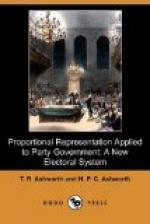The best way to overcome the difficulty is undoubtedly by some process of gradually eliminating the least popular candidates till the number is reduced to two; the candidate with the absolute majority is then elected. We propose to consider the different ways in which elimination might be made. We assume, in the first place, that each elector has cast an advance vote—i.e., that he has placed all the candidates in order of preference. The most primitive method is to eliminate at each successive count the candidate who has least first preferences. This is the method adopted in the Hare system, and we have already shown that it is very defective; in fact, it is no improvement at all. The eliminated candidate might be most in general favour, and might be able to beat each of the other candidates single-handed. A second method is to use Preferential Voting to decide which candidate should be eliminated at each successive count. This is far superior, but it is extremely complicated, and is open to the objection that when there are a large number of candidates a small section may cause the rejection of the general favourite. We propose to describe a method based on the Block Vote which is much simpler, and which does not lend itself to abuse. We have shown that the Block Vote works best when the candidates can be divided into two equal sections of favour and non-favour. Suppose there are four candidates, the first two preferences should therefore be counted as effective votes, instead of the first preference only. The eliminated candidate will then be the least in general favour. A second count is then made of the three candidates left, and the first preferences and half of the second preferences are counted as effective, and the lowest again eliminated. The candidate who has an absolute majority is then elected. The method may be indefinitely extended; if there are five candidates the first two preferences and one-half of the third preferences are counted, and so on. But when there are a great many candidates more than one might be eliminated. Any number up to eight could be safely reduced to four at the first count.
FOOTNOTE:
[8] The bracket principle introduced by Professor Nanson into the Hare system involves a partial recognition of this fact.
CHAPTER IX.
ATTEMPTS TO IMPROVE THE PRESENT SYSTEM.
+The Double Election.+—In the preceding chapter we have strongly insisted that the different methods considered for ensuring the return of the candidate acceptable to all sections are not applicable to the election of legislators. The true principles of political representation require, not the election of the candidate most in general favour with both parties, but the election by each party separately of its own most favoured candidates. But as it is impossible for both parties to be represented in a single-membered electorate, the best alternative




